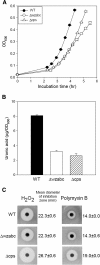Capsule deletion via a λ-Red knockout system perturbs biofilm formation and fimbriae expression in Klebsiella pneumoniae MGH 78578
- PMID: 24398052
- PMCID: PMC3892127
- DOI: 10.1186/1756-0500-7-13
Capsule deletion via a λ-Red knockout system perturbs biofilm formation and fimbriae expression in Klebsiella pneumoniae MGH 78578
Abstract
Background: Klebsiella pneumoniae is a leading cause of hospital-acquired urinary tract infections and pneumonia worldwide, and is responsible for many cases of pyogenic liver abscess among diabetic patients in Asia. A defining characteristic of this pathogen is the presence of a thick, exterior capsule that has been reported to play a role in biofilm formation and to protect the organism from threats such antibiotics and host immune challenge.
Findings: We constructed two knockout mutants of K. pneumoniae to investigate how perturbations to capsule biosynthesis alter the cellular phenotype. In the first mutant, we deleted the entire gene cluster responsible for biosynthesis of the extracellular polysaccharide capsule. In the second mutant, we deleted the capsule export subsystem within this cluster. We find that both knockout mutants have lower amounts of capsule but produce greater amounts of biofilm. Moreover, one of the two mutants abolishes fimbriae expression as well.
Conclusions: These results are expected to provide insight into the interaction between capsule biosynthesis, biofilm formation, and fimbriae expression in this organism.
Figures




References
-
- Siu LK, Fung CP, Chang FY, Lee N, Yeh KM, Koh TH, Ip M. Molecular typing and virulence analysis of serotype K1 Klebsiella pneumoniae strains isolated from liver abscess patients and stool samples from noninfectious subjects in Hong Kong, Singapore, and Taiwan. J Clin Microbiol. 2011;49:3761–3765. doi: 10.1128/JCM.00977-11. - DOI - PMC - PubMed
Publication types
MeSH terms
Substances
LinkOut - more resources
Full Text Sources
Other Literature Sources
Molecular Biology Databases
Research Materials

